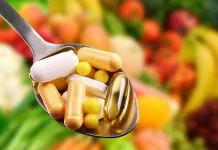
Elevating Moods in Winter: A Food Guide to Combating Seasonal Affective Disorder”
Winter can be a challenging time for many, with the shorter days and longer nights often leading to a drop in mood. For those battling Seasonal Affective Disorder (SAD), it’s not just about enduring the cold; it’s about navigating a complex mood disorder that affects millions each year, predominantly women.
Understanding that our readers are well-versed in this topic, we delve deeper into the nutritional strategies to combat SAD. It’s not just about eating healthier; it’s about strategically choosing foods that support mental well-being during these trying months.
1. Oatmeal: The Brain-Boosting Breakfast
Oatmeal, a humble yet powerful ally in the fight against SAD, is more than just a warm breakfast option. It’s a rich source of folic acid, a key player in boosting mood and aiding the production of serotonin, the ‘feel-good’ neurotransmitter. For the maximum impact, opt for steel-cut or rolled oats over instant varieties to stabilize blood sugar levels. Enhance your oatmeal with sunflower seeds and fresh berries for a folate and antioxidant-rich meal, elevating mood even further.
2. Salmon: The Mood-Lifting Powerhouse
Salmon, known for its omega-3 fatty acids and vitamin D content, is a top contender in mood regulation. These nutrients are vital for brain health and have been linked to alleviating symptoms of SAD. Remember, the source of your salmon matters. Choose sustainably-caught, wild salmon for the highest nutrient content. Combine it with other omega-3 rich foods like flax seeds, walnuts, and vitamin D-enriched eggs for a mood-boosting meal.
3. Pumpkin Seeds: The Magnesium Miracle
Pumpkin seeds, a seasonal favorite, are loaded with magnesium, a mineral essential for relaxation and stress reduction. Their high tryptophan content also aids in serotonin and melatonin production, balancing mood and sleep. These versatile seeds can be added to salads, soups, or even your morning oatmeal for an extra crunch and a significant mood lift.
4. Avocados: The Creamy Mood Enhancer
Avocados are not just trendy; they’re packed with mood-boosting B vitamins and healthy fats. These nutrients are critical in energy production, fat burning, and maintaining healthy skin—a bonus during dry winter months. Whether in guacamole, smoothies, or even as a base for a chocolate avocado mousse, avocados are a delicious way to combat SAD.
5. Dark Chocolate: The Sweet Antidote
Dark chocolate is more than a guilty pleasure; it’s a potent mood enhancer. Its high antioxidant and magnesium content can significantly impact stress and depression. Opt for a bar with at least 75% cocoa content to reap the benefits without the downsides of excess sugar.
When considering supplements to combat Seasonal Affective Disorder (SAD), it’s essential to approach this with a balance of scientific insight and caution, as supplements can interact with medications or have side effects. Here’s a breakdown of some supplements commonly recommended for SAD and their suggested dosages. However, it’s crucial to consult with a healthcare provider before starting any new supplement regimen, especially if you have existing health conditions or are taking other medications.
1. Vitamin D
- Role: Often called the “sunshine vitamin,” Vitamin D is crucial for mood regulation and is often lacking during the winter months.
- Suggested Dosage: The recommended daily allowance (RDA) is typically around 600-800 IU, but some studies suggest higher doses (1,000-2,000 IU) may be beneficial for SAD. However, it’s important not to exceed the upper limit of 4,000 IU unless advised by a healthcare provider.
2. Omega-3 Fatty Acids
- Role: Essential for brain health and mood regulation. They are especially important for people who don’t consume enough omega-3 rich foods like fish.
- Suggested Dosage: A common recommendation is 1,000-2,000 mg per day. However, dosages can vary based on individual needs and product formulations.
3. Magnesium
- Role: Helps with relaxation and stress reduction. Magnesium deficiency can negatively impact mood and sleep.
- Suggested Dosage: The RDA for magnesium is around 310-420 mg for adults, depending on age and gender. Supplements should not exceed 350 mg per day unless prescribed.
4. B Vitamins
- Role: B vitamins, particularly B6, B9 (folate), and B12, are vital for mood and energy levels.
- Suggested Dosage: B-complex supplements typically include all eight B vitamins in various amounts. It’s important to follow the manufacturer’s recommended dosage.
5. St. John’s Wort
- Role: Often used for mild to moderate depression. It’s important to note that St. John’s Wort can interact with many medications.
- Suggested Dosage: Dosages can vary, but a common amount is 300 mg three times a day. Always check with a healthcare provider due to potential interactions.
6. 5-HTP (5-Hydroxytryptophan)
- Role: A precursor to serotonin, it may help boost mood.
- Suggested Dosage: Typical doses of 5-HTP range from 100-300 mg per day, taken in divided doses.
7. SAM-e (S-adenosylmethionine)
- Role: It’s thought to increase levels of neurotransmitters serotonin and dopamine.
- Suggested Dosage: Starting doses are usually around 400-600 mg per day, increasing as needed under medical supervision.
Key Considerations:
- Quality Matters: Look for supplements that have been third-party tested for purity and accuracy.
- Individual Variability: Everyone’s body responds differently to supplements, so what works for one person may not work for another.
- Medical Advice: Always consult with a healthcare provider before starting any supplement, especially if you are pregnant, nursing, have a medical condition, or are taking other medications.
In conclusion, while the winter season can be demanding, incorporating foods into your diet can play a significant role in managing SAD. It’s about embracing each season’s uniqueness and finding joy and balance through thoughtful nutrition. Remember, it’s not just about fighting the winter blues; it’s about thriving through every season.By combining the right supplements with a healthy diet, exercise, and possibly light therapy or counseling, individuals with SAD can better manage their symptoms and improve their overall well-being during the challenging winter months.











